Leadership in Organizations
VerifiedAdded on 2021/05/30
|8
|2044
|95
AI Summary
LEADERSHIP 7 LEADERSHIP LEADERSHIP Name of the Student Name of the University Author Note An organization is a social group and for this purpose it is extremely important for an organization to be guided by a leader who knows the right path and is largely successful in leading the people to the right direction in which they will be able to achieve success for themselves as well as for the organization where they work in. I believe that knowing the way is a critical aspect of a leader and that if the leader is
Contribute Materials
Your contribution can guide someone’s learning journey. Share your
documents today.
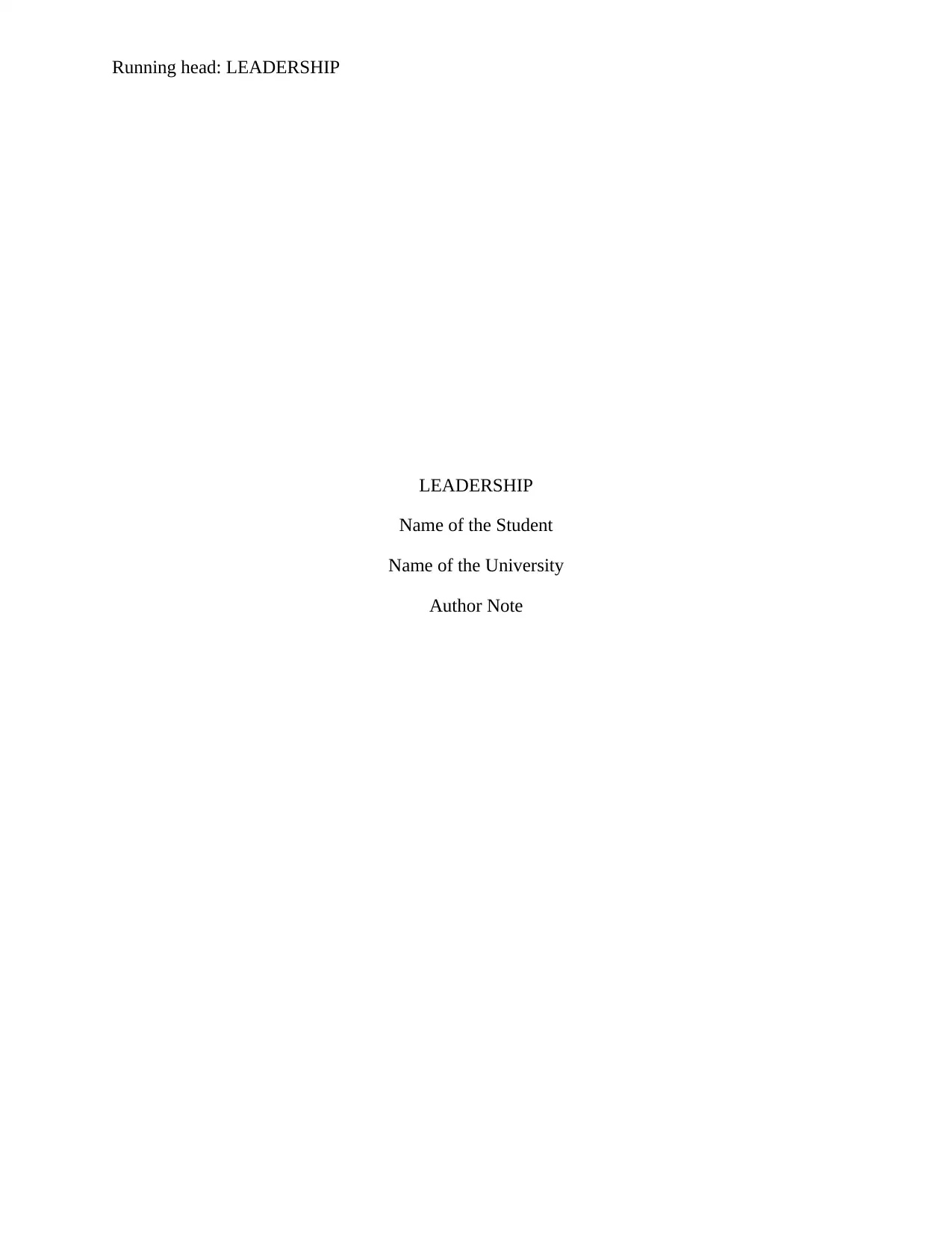
Running head: LEADERSHIP
LEADERSHIP
Name of the Student
Name of the University
Author Note
LEADERSHIP
Name of the Student
Name of the University
Author Note
Secure Best Marks with AI Grader
Need help grading? Try our AI Grader for instant feedback on your assignments.
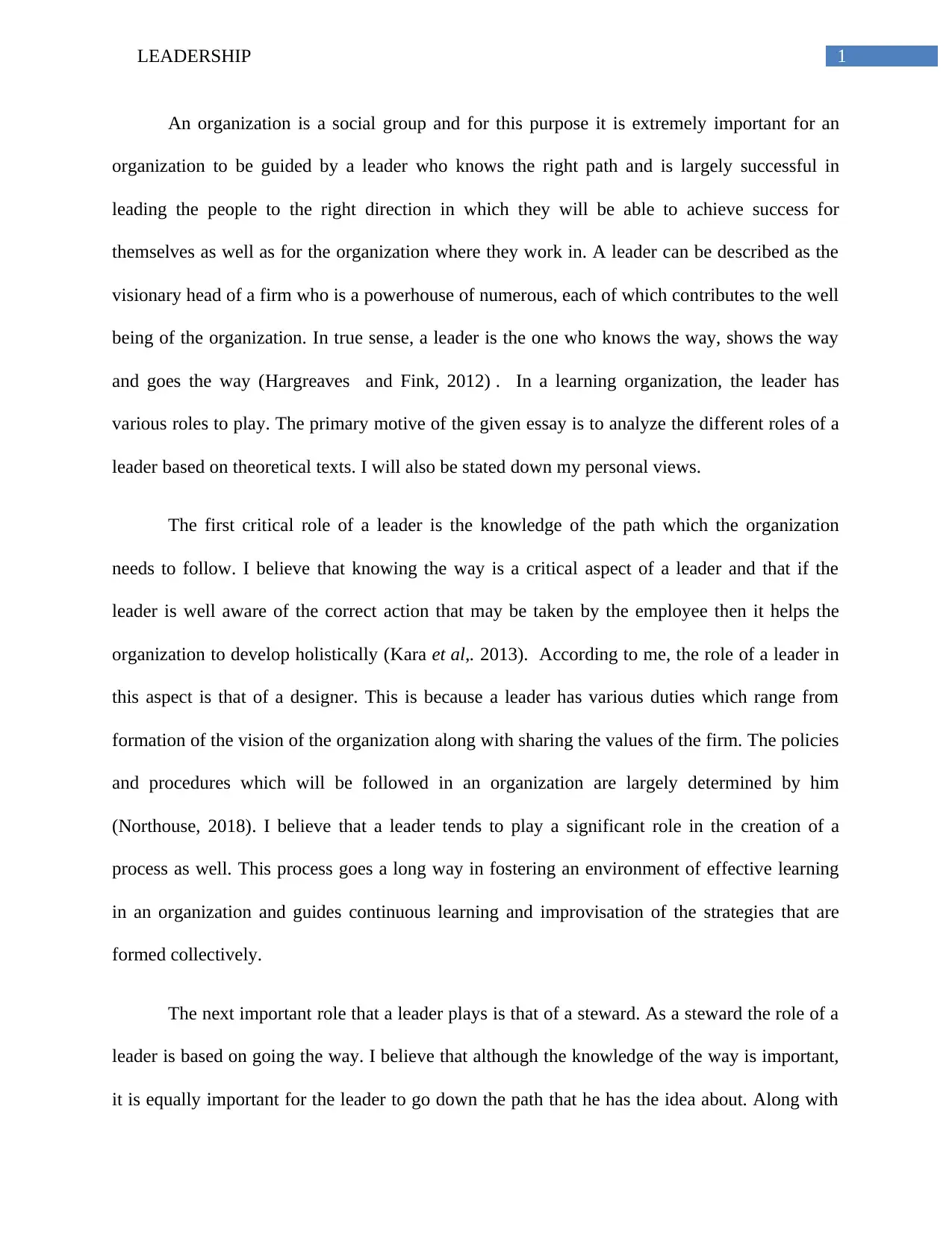
1LEADERSHIP
An organization is a social group and for this purpose it is extremely important for an
organization to be guided by a leader who knows the right path and is largely successful in
leading the people to the right direction in which they will be able to achieve success for
themselves as well as for the organization where they work in. A leader can be described as the
visionary head of a firm who is a powerhouse of numerous, each of which contributes to the well
being of the organization. In true sense, a leader is the one who knows the way, shows the way
and goes the way (Hargreaves and Fink, 2012) . In a learning organization, the leader has
various roles to play. The primary motive of the given essay is to analyze the different roles of a
leader based on theoretical texts. I will also be stated down my personal views.
The first critical role of a leader is the knowledge of the path which the organization
needs to follow. I believe that knowing the way is a critical aspect of a leader and that if the
leader is well aware of the correct action that may be taken by the employee then it helps the
organization to develop holistically (Kara et al,. 2013). According to me, the role of a leader in
this aspect is that of a designer. This is because a leader has various duties which range from
formation of the vision of the organization along with sharing the values of the firm. The policies
and procedures which will be followed in an organization are largely determined by him
(Northouse, 2018). I believe that a leader tends to play a significant role in the creation of a
process as well. This process goes a long way in fostering an environment of effective learning
in an organization and guides continuous learning and improvisation of the strategies that are
formed collectively.
The next important role that a leader plays is that of a steward. As a steward the role of a
leader is based on going the way. I believe that although the knowledge of the way is important,
it is equally important for the leader to go down the path that he has the idea about. Along with
An organization is a social group and for this purpose it is extremely important for an
organization to be guided by a leader who knows the right path and is largely successful in
leading the people to the right direction in which they will be able to achieve success for
themselves as well as for the organization where they work in. A leader can be described as the
visionary head of a firm who is a powerhouse of numerous, each of which contributes to the well
being of the organization. In true sense, a leader is the one who knows the way, shows the way
and goes the way (Hargreaves and Fink, 2012) . In a learning organization, the leader has
various roles to play. The primary motive of the given essay is to analyze the different roles of a
leader based on theoretical texts. I will also be stated down my personal views.
The first critical role of a leader is the knowledge of the path which the organization
needs to follow. I believe that knowing the way is a critical aspect of a leader and that if the
leader is well aware of the correct action that may be taken by the employee then it helps the
organization to develop holistically (Kara et al,. 2013). According to me, the role of a leader in
this aspect is that of a designer. This is because a leader has various duties which range from
formation of the vision of the organization along with sharing the values of the firm. The policies
and procedures which will be followed in an organization are largely determined by him
(Northouse, 2018). I believe that a leader tends to play a significant role in the creation of a
process as well. This process goes a long way in fostering an environment of effective learning
in an organization and guides continuous learning and improvisation of the strategies that are
formed collectively.
The next important role that a leader plays is that of a steward. As a steward the role of a
leader is based on going the way. I believe that although the knowledge of the way is important,
it is equally important for the leader to go down the path that he has the idea about. Along with
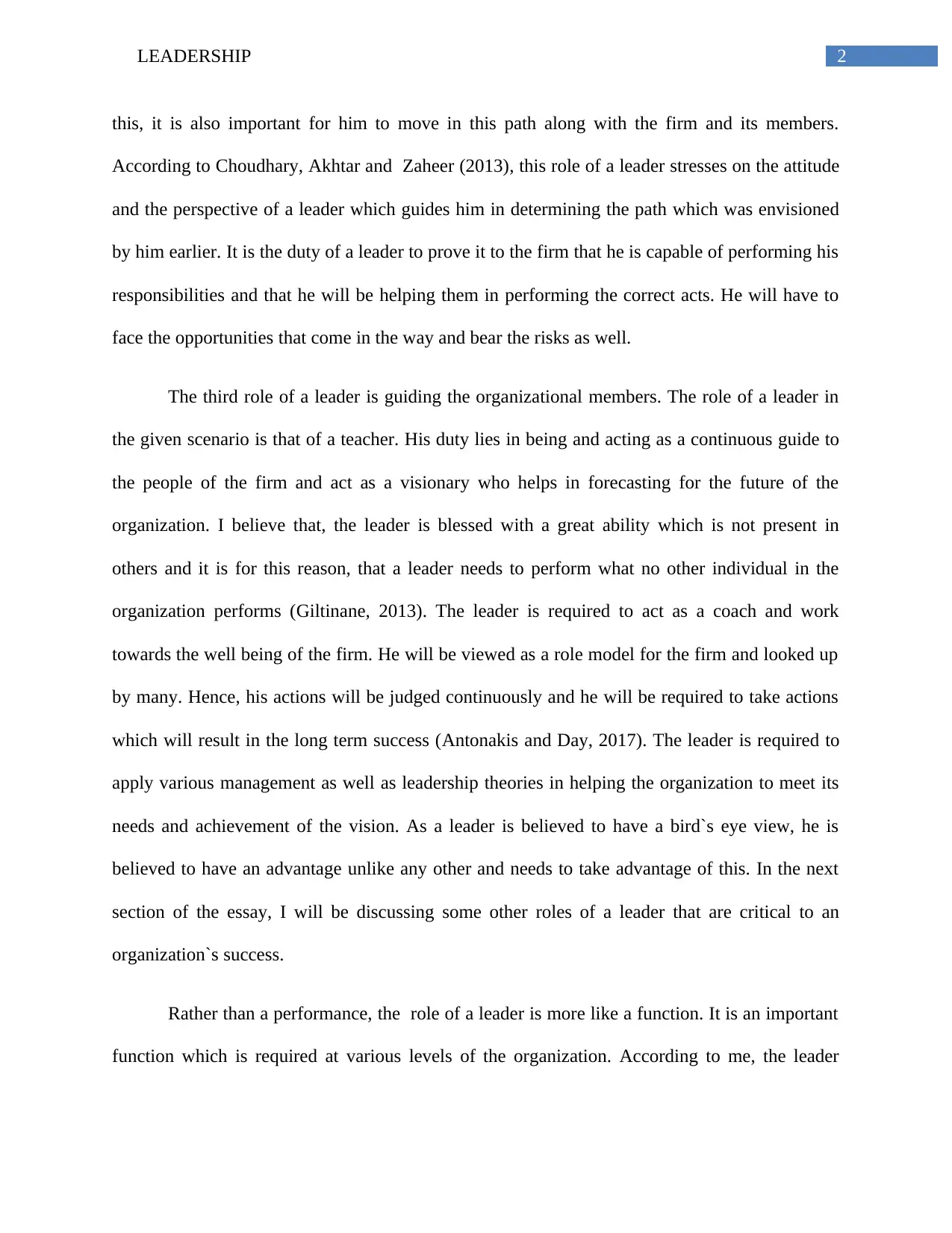
2LEADERSHIP
this, it is also important for him to move in this path along with the firm and its members.
According to Choudhary, Akhtar and Zaheer (2013), this role of a leader stresses on the attitude
and the perspective of a leader which guides him in determining the path which was envisioned
by him earlier. It is the duty of a leader to prove it to the firm that he is capable of performing his
responsibilities and that he will be helping them in performing the correct acts. He will have to
face the opportunities that come in the way and bear the risks as well.
The third role of a leader is guiding the organizational members. The role of a leader in
the given scenario is that of a teacher. His duty lies in being and acting as a continuous guide to
the people of the firm and act as a visionary who helps in forecasting for the future of the
organization. I believe that, the leader is blessed with a great ability which is not present in
others and it is for this reason, that a leader needs to perform what no other individual in the
organization performs (Giltinane, 2013). The leader is required to act as a coach and work
towards the well being of the firm. He will be viewed as a role model for the firm and looked up
by many. Hence, his actions will be judged continuously and he will be required to take actions
which will result in the long term success (Antonakis and Day, 2017). The leader is required to
apply various management as well as leadership theories in helping the organization to meet its
needs and achievement of the vision. As a leader is believed to have a bird`s eye view, he is
believed to have an advantage unlike any other and needs to take advantage of this. In the next
section of the essay, I will be discussing some other roles of a leader that are critical to an
organization`s success.
Rather than a performance, the role of a leader is more like a function. It is an important
function which is required at various levels of the organization. According to me, the leader
this, it is also important for him to move in this path along with the firm and its members.
According to Choudhary, Akhtar and Zaheer (2013), this role of a leader stresses on the attitude
and the perspective of a leader which guides him in determining the path which was envisioned
by him earlier. It is the duty of a leader to prove it to the firm that he is capable of performing his
responsibilities and that he will be helping them in performing the correct acts. He will have to
face the opportunities that come in the way and bear the risks as well.
The third role of a leader is guiding the organizational members. The role of a leader in
the given scenario is that of a teacher. His duty lies in being and acting as a continuous guide to
the people of the firm and act as a visionary who helps in forecasting for the future of the
organization. I believe that, the leader is blessed with a great ability which is not present in
others and it is for this reason, that a leader needs to perform what no other individual in the
organization performs (Giltinane, 2013). The leader is required to act as a coach and work
towards the well being of the firm. He will be viewed as a role model for the firm and looked up
by many. Hence, his actions will be judged continuously and he will be required to take actions
which will result in the long term success (Antonakis and Day, 2017). The leader is required to
apply various management as well as leadership theories in helping the organization to meet its
needs and achievement of the vision. As a leader is believed to have a bird`s eye view, he is
believed to have an advantage unlike any other and needs to take advantage of this. In the next
section of the essay, I will be discussing some other roles of a leader that are critical to an
organization`s success.
Rather than a performance, the role of a leader is more like a function. It is an important
function which is required at various levels of the organization. According to me, the leader
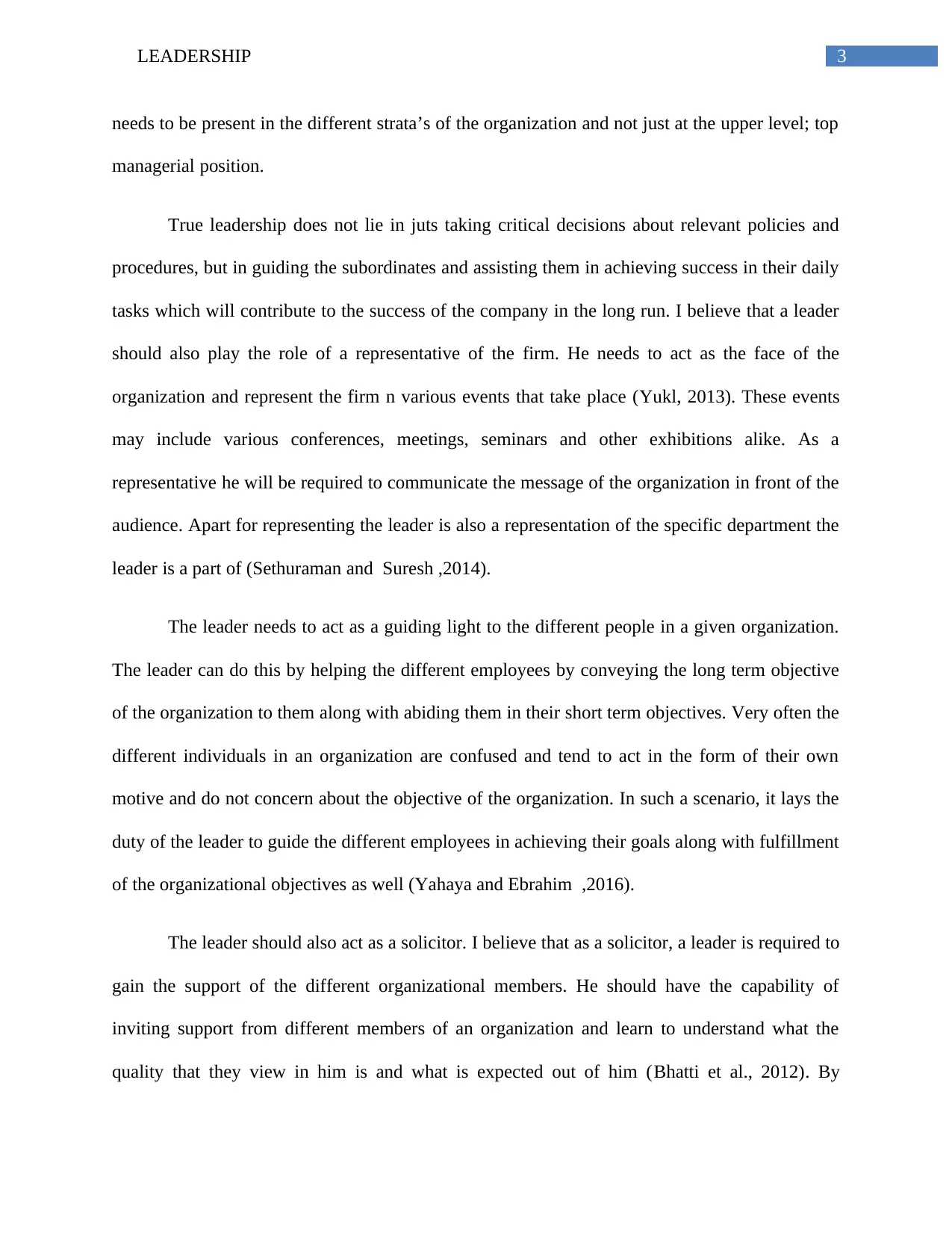
3LEADERSHIP
needs to be present in the different strata’s of the organization and not just at the upper level; top
managerial position.
True leadership does not lie in juts taking critical decisions about relevant policies and
procedures, but in guiding the subordinates and assisting them in achieving success in their daily
tasks which will contribute to the success of the company in the long run. I believe that a leader
should also play the role of a representative of the firm. He needs to act as the face of the
organization and represent the firm n various events that take place (Yukl, 2013). These events
may include various conferences, meetings, seminars and other exhibitions alike. As a
representative he will be required to communicate the message of the organization in front of the
audience. Apart for representing the leader is also a representation of the specific department the
leader is a part of (Sethuraman and Suresh ,2014).
The leader needs to act as a guiding light to the different people in a given organization.
The leader can do this by helping the different employees by conveying the long term objective
of the organization to them along with abiding them in their short term objectives. Very often the
different individuals in an organization are confused and tend to act in the form of their own
motive and do not concern about the objective of the organization. In such a scenario, it lays the
duty of the leader to guide the different employees in achieving their goals along with fulfillment
of the organizational objectives as well (Yahaya and Ebrahim ,2016).
The leader should also act as a solicitor. I believe that as a solicitor, a leader is required to
gain the support of the different organizational members. He should have the capability of
inviting support from different members of an organization and learn to understand what the
quality that they view in him is and what is expected out of him (Bhatti et al., 2012). By
needs to be present in the different strata’s of the organization and not just at the upper level; top
managerial position.
True leadership does not lie in juts taking critical decisions about relevant policies and
procedures, but in guiding the subordinates and assisting them in achieving success in their daily
tasks which will contribute to the success of the company in the long run. I believe that a leader
should also play the role of a representative of the firm. He needs to act as the face of the
organization and represent the firm n various events that take place (Yukl, 2013). These events
may include various conferences, meetings, seminars and other exhibitions alike. As a
representative he will be required to communicate the message of the organization in front of the
audience. Apart for representing the leader is also a representation of the specific department the
leader is a part of (Sethuraman and Suresh ,2014).
The leader needs to act as a guiding light to the different people in a given organization.
The leader can do this by helping the different employees by conveying the long term objective
of the organization to them along with abiding them in their short term objectives. Very often the
different individuals in an organization are confused and tend to act in the form of their own
motive and do not concern about the objective of the organization. In such a scenario, it lays the
duty of the leader to guide the different employees in achieving their goals along with fulfillment
of the organizational objectives as well (Yahaya and Ebrahim ,2016).
The leader should also act as a solicitor. I believe that as a solicitor, a leader is required to
gain the support of the different organizational members. He should have the capability of
inviting support from different members of an organization and learn to understand what the
quality that they view in him is and what is expected out of him (Bhatti et al., 2012). By
Secure Best Marks with AI Grader
Need help grading? Try our AI Grader for instant feedback on your assignments.
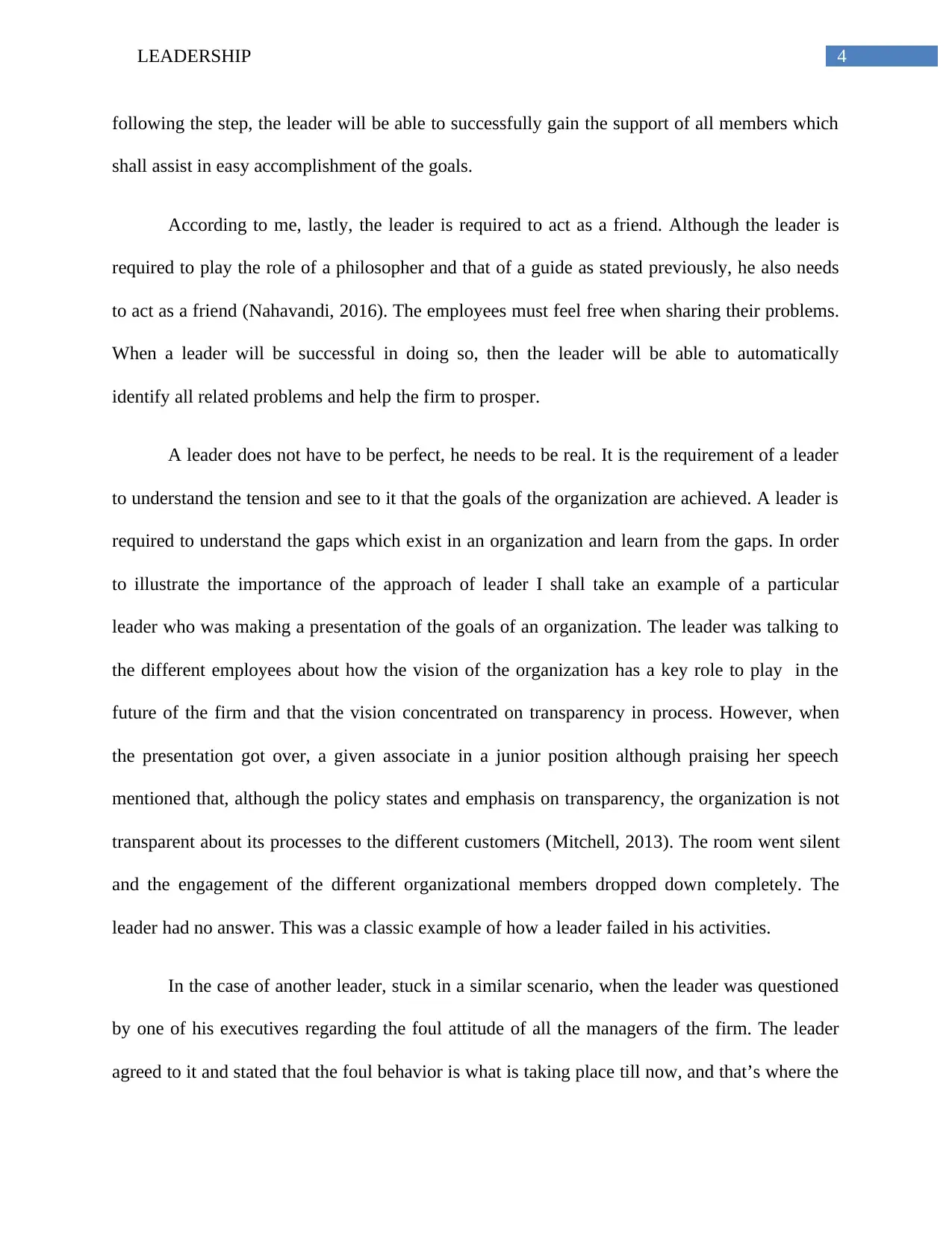
4LEADERSHIP
following the step, the leader will be able to successfully gain the support of all members which
shall assist in easy accomplishment of the goals.
According to me, lastly, the leader is required to act as a friend. Although the leader is
required to play the role of a philosopher and that of a guide as stated previously, he also needs
to act as a friend (Nahavandi, 2016). The employees must feel free when sharing their problems.
When a leader will be successful in doing so, then the leader will be able to automatically
identify all related problems and help the firm to prosper.
A leader does not have to be perfect, he needs to be real. It is the requirement of a leader
to understand the tension and see to it that the goals of the organization are achieved. A leader is
required to understand the gaps which exist in an organization and learn from the gaps. In order
to illustrate the importance of the approach of leader I shall take an example of a particular
leader who was making a presentation of the goals of an organization. The leader was talking to
the different employees about how the vision of the organization has a key role to play in the
future of the firm and that the vision concentrated on transparency in process. However, when
the presentation got over, a given associate in a junior position although praising her speech
mentioned that, although the policy states and emphasis on transparency, the organization is not
transparent about its processes to the different customers (Mitchell, 2013). The room went silent
and the engagement of the different organizational members dropped down completely. The
leader had no answer. This was a classic example of how a leader failed in his activities.
In the case of another leader, stuck in a similar scenario, when the leader was questioned
by one of his executives regarding the foul attitude of all the managers of the firm. The leader
agreed to it and stated that the foul behavior is what is taking place till now, and that’s where the
following the step, the leader will be able to successfully gain the support of all members which
shall assist in easy accomplishment of the goals.
According to me, lastly, the leader is required to act as a friend. Although the leader is
required to play the role of a philosopher and that of a guide as stated previously, he also needs
to act as a friend (Nahavandi, 2016). The employees must feel free when sharing their problems.
When a leader will be successful in doing so, then the leader will be able to automatically
identify all related problems and help the firm to prosper.
A leader does not have to be perfect, he needs to be real. It is the requirement of a leader
to understand the tension and see to it that the goals of the organization are achieved. A leader is
required to understand the gaps which exist in an organization and learn from the gaps. In order
to illustrate the importance of the approach of leader I shall take an example of a particular
leader who was making a presentation of the goals of an organization. The leader was talking to
the different employees about how the vision of the organization has a key role to play in the
future of the firm and that the vision concentrated on transparency in process. However, when
the presentation got over, a given associate in a junior position although praising her speech
mentioned that, although the policy states and emphasis on transparency, the organization is not
transparent about its processes to the different customers (Mitchell, 2013). The room went silent
and the engagement of the different organizational members dropped down completely. The
leader had no answer. This was a classic example of how a leader failed in his activities.
In the case of another leader, stuck in a similar scenario, when the leader was questioned
by one of his executives regarding the foul attitude of all the managers of the firm. The leader
agreed to it and stated that the foul behavior is what is taking place till now, and that’s where the
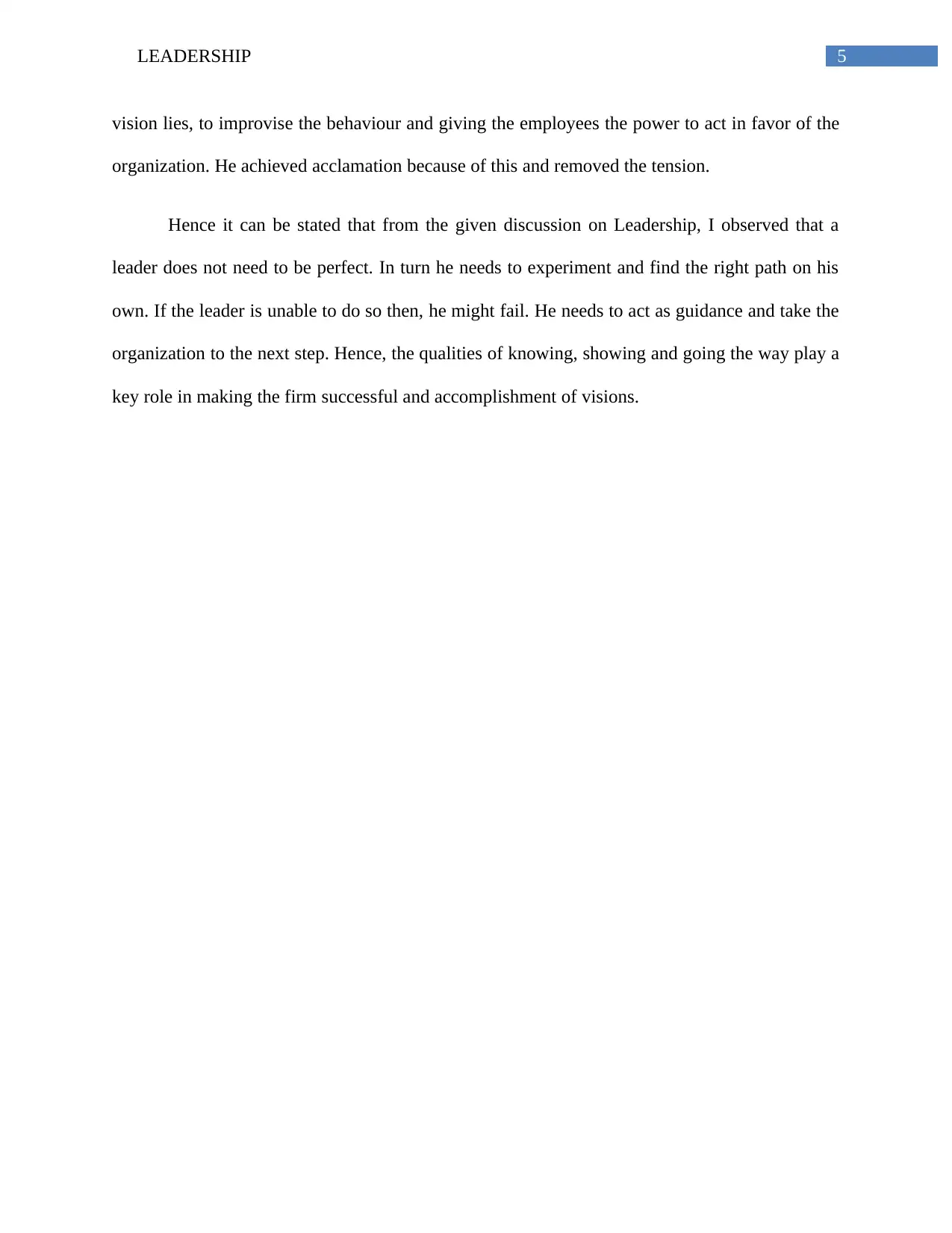
5LEADERSHIP
vision lies, to improvise the behaviour and giving the employees the power to act in favor of the
organization. He achieved acclamation because of this and removed the tension.
Hence it can be stated that from the given discussion on Leadership, I observed that a
leader does not need to be perfect. In turn he needs to experiment and find the right path on his
own. If the leader is unable to do so then, he might fail. He needs to act as guidance and take the
organization to the next step. Hence, the qualities of knowing, showing and going the way play a
key role in making the firm successful and accomplishment of visions.
vision lies, to improvise the behaviour and giving the employees the power to act in favor of the
organization. He achieved acclamation because of this and removed the tension.
Hence it can be stated that from the given discussion on Leadership, I observed that a
leader does not need to be perfect. In turn he needs to experiment and find the right path on his
own. If the leader is unable to do so then, he might fail. He needs to act as guidance and take the
organization to the next step. Hence, the qualities of knowing, showing and going the way play a
key role in making the firm successful and accomplishment of visions.
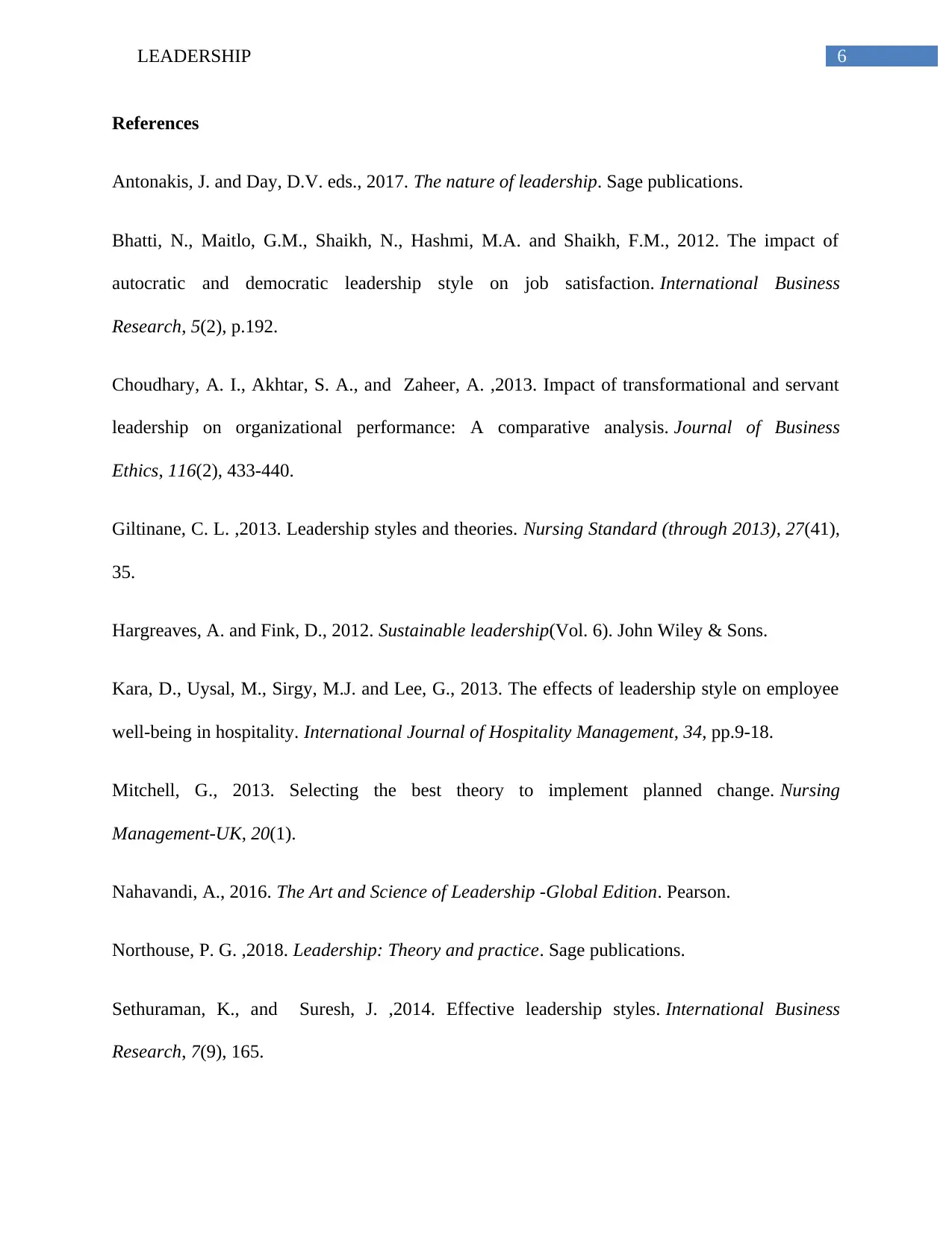
6LEADERSHIP
References
Antonakis, J. and Day, D.V. eds., 2017. The nature of leadership. Sage publications.
Bhatti, N., Maitlo, G.M., Shaikh, N., Hashmi, M.A. and Shaikh, F.M., 2012. The impact of
autocratic and democratic leadership style on job satisfaction. International Business
Research, 5(2), p.192.
Choudhary, A. I., Akhtar, S. A., and Zaheer, A. ,2013. Impact of transformational and servant
leadership on organizational performance: A comparative analysis. Journal of Business
Ethics, 116(2), 433-440.
Giltinane, C. L. ,2013. Leadership styles and theories. Nursing Standard (through 2013), 27(41),
35.
Hargreaves, A. and Fink, D., 2012. Sustainable leadership(Vol. 6). John Wiley & Sons.
Kara, D., Uysal, M., Sirgy, M.J. and Lee, G., 2013. The effects of leadership style on employee
well-being in hospitality. International Journal of Hospitality Management, 34, pp.9-18.
Mitchell, G., 2013. Selecting the best theory to implement planned change. Nursing
Management-UK, 20(1).
Nahavandi, A., 2016. The Art and Science of Leadership -Global Edition. Pearson.
Northouse, P. G. ,2018. Leadership: Theory and practice. Sage publications.
Sethuraman, K., and Suresh, J. ,2014. Effective leadership styles. International Business
Research, 7(9), 165.
References
Antonakis, J. and Day, D.V. eds., 2017. The nature of leadership. Sage publications.
Bhatti, N., Maitlo, G.M., Shaikh, N., Hashmi, M.A. and Shaikh, F.M., 2012. The impact of
autocratic and democratic leadership style on job satisfaction. International Business
Research, 5(2), p.192.
Choudhary, A. I., Akhtar, S. A., and Zaheer, A. ,2013. Impact of transformational and servant
leadership on organizational performance: A comparative analysis. Journal of Business
Ethics, 116(2), 433-440.
Giltinane, C. L. ,2013. Leadership styles and theories. Nursing Standard (through 2013), 27(41),
35.
Hargreaves, A. and Fink, D., 2012. Sustainable leadership(Vol. 6). John Wiley & Sons.
Kara, D., Uysal, M., Sirgy, M.J. and Lee, G., 2013. The effects of leadership style on employee
well-being in hospitality. International Journal of Hospitality Management, 34, pp.9-18.
Mitchell, G., 2013. Selecting the best theory to implement planned change. Nursing
Management-UK, 20(1).
Nahavandi, A., 2016. The Art and Science of Leadership -Global Edition. Pearson.
Northouse, P. G. ,2018. Leadership: Theory and practice. Sage publications.
Sethuraman, K., and Suresh, J. ,2014. Effective leadership styles. International Business
Research, 7(9), 165.
Paraphrase This Document
Need a fresh take? Get an instant paraphrase of this document with our AI Paraphraser
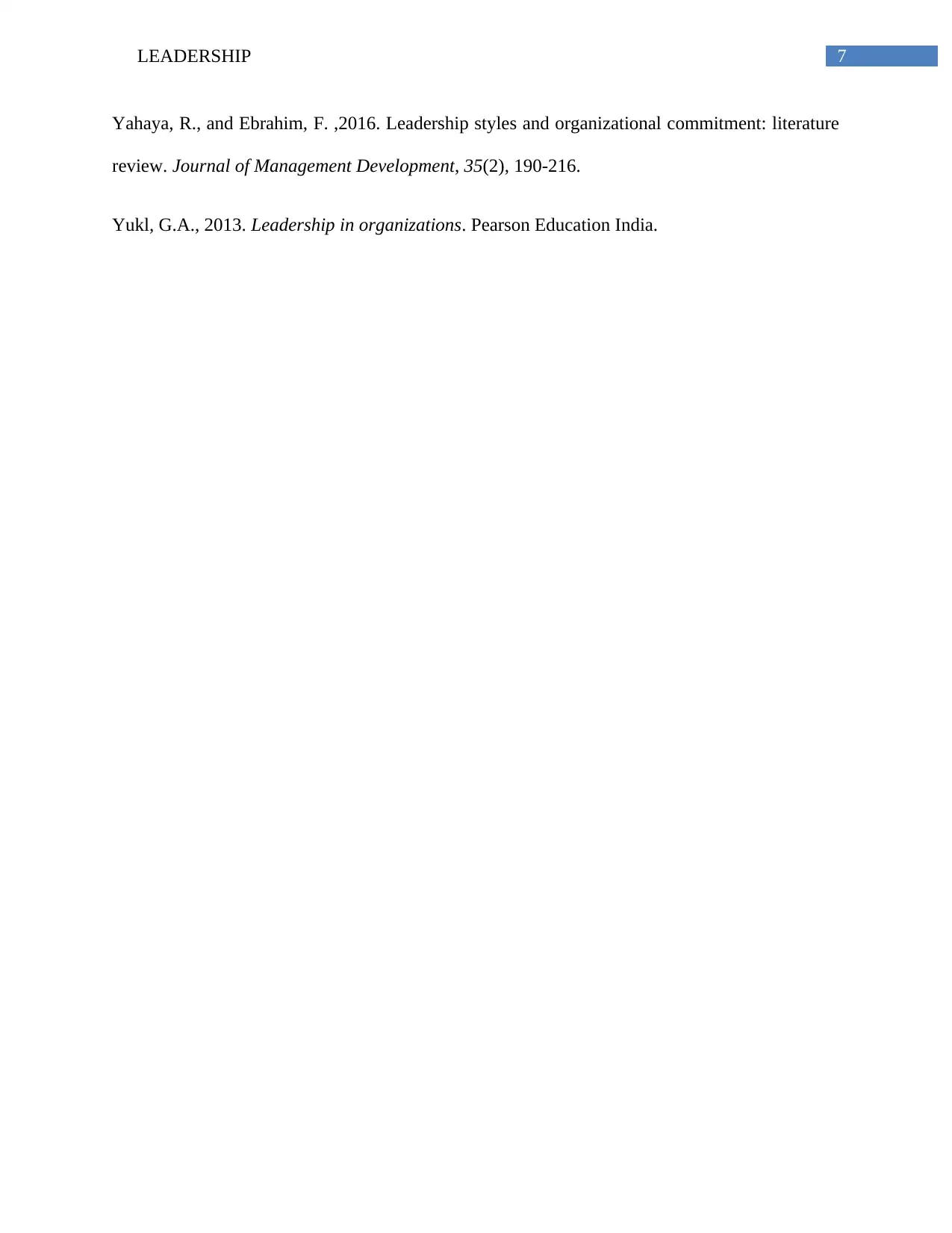
7LEADERSHIP
Yahaya, R., and Ebrahim, F. ,2016. Leadership styles and organizational commitment: literature
review. Journal of Management Development, 35(2), 190-216.
Yukl, G.A., 2013. Leadership in organizations. Pearson Education India.
Yahaya, R., and Ebrahim, F. ,2016. Leadership styles and organizational commitment: literature
review. Journal of Management Development, 35(2), 190-216.
Yukl, G.A., 2013. Leadership in organizations. Pearson Education India.
1 out of 8
Related Documents
Your All-in-One AI-Powered Toolkit for Academic Success.
+13062052269
info@desklib.com
Available 24*7 on WhatsApp / Email
![[object Object]](/_next/static/media/star-bottom.7253800d.svg)
Unlock your academic potential
© 2024 | Zucol Services PVT LTD | All rights reserved.




